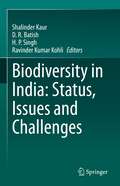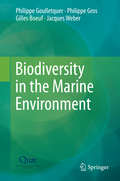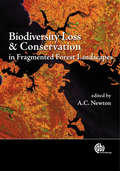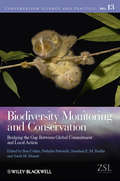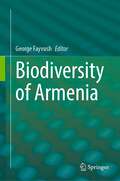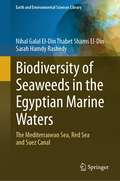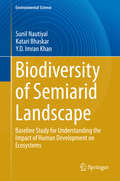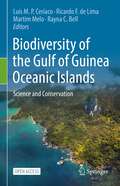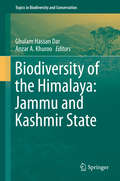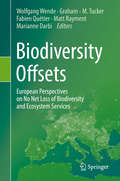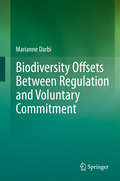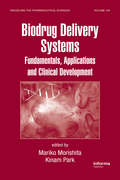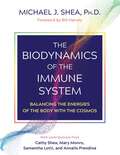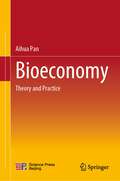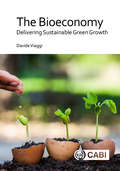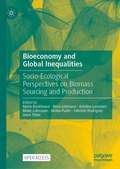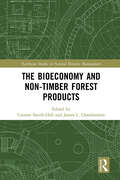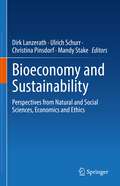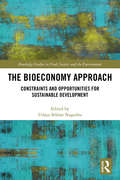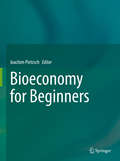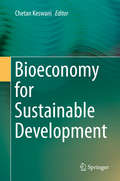- Table View
- List View
Biodiversity in India: Status, Issues and Challenges
by Shalinder Kaur D. R. Batish H. P. Singh Ravinder Kumar KohliThis contributed book is based on the current status of biodiversity in India, issues and challenges faced by the authorities involved in conservation efforts, and the imperative role of various direct and indirect stakeholders in biodiversity conservation. The book discusses the current status of different forms of biodiversity in India, challenges faced by stakeholders, issues and reasons for biodiversity losses, and efforts by government through various laws, policies, and programs in a concise and comprehensive manner throughout its many chapters. In this way, readers can access diverse information on Indian biodiversity through this book. It is compiled by leading experts in the field of conservation. In 18 chapters, it covers biodiversity of both fauna and flora, on land and in aquatic ecosystems, legal and policy aspects, as well as innovative conservation tool and techniques. It is useful for undergraduates and graduate students and also educates policy planners, bureaucrats, foresters, and researchers in India and abroad.
Biodiversity in the Marine Environment
by Philippe Goulletquer Philippe Gros Gilles Boeuf Jacques WeberThe oceans cover over 70% of our planet. They are host to a biodiversity of tremendous wealth. Its preservation is now a global priority featuring in several international conventions and a confirmed objective of European policies and national strategies. Understanding the dynamics and the uses of the marine biodiversity is a genuine scientific challenge. Fourteen international experts have got together and identified five priority research themes to address the problem, based on analysing the state of knowledge.
Biodiversity Islands: Strategies for Conservation in Human-Dominated Environments (Topics in Biodiversity and Conservation #20)
by Florencia MontagniniThis book is intended to provide an overview for the identification and establishment of biodiversity islands. It presents examples and case studies where the biodiversity islands approach is being used in a variety of locations and contexts worldwide. It will contribute to design parameters on appropriate sizing and spatial distribution of biodiversity islands in order to be effective in conservation and regeneration across the landscape, using integrated landscape management approaches. This book is essential given the current worldwide trend of habitat destruction and the need to preserve biodiversity and its values. The chapters are organized in five sections. The first section provides the introduction. Section 2,3 and 4 discuss the challenges and alternatives of establishment and management, case studies across the globe, safeguarding of the environmental, economic, and social benefits, and the final section offers a conclusion. The contributing authors present views from the academic, the practitioner and the policymaker perspectives, offering alternatives and suggestions for promoting strategies that support biodiversity conservation through intentionally designed frameworks for sustainable forest landscapes. Readers will discover suggestions and concrete examples that can be used by a variety of stakeholders in various settings throughout the world. This book is useful to researchers, farmers, foresters, landowners, land managers, city planners, and policy makers alike.
Biodiversity Loss and Conservation in Fragmented Forest Landscapes: Evidence from Tropical Montane and South Temperate Rain Forests in Latin America
by A. C. NewtonThe studies reported allow for comparative analysis across areas and help identify how human disturbance has impacted the biodiversity of all forest types. Chapters incorporate features of landscape ecology, floristic biodiversity, conservation and policy and vary from in-depth investigations of a single study area to integrated examinations across regions.
Biodiversity Monitoring and Conservation: Bridging the Gap Between Global Commitment and Local Action (Conservation Science and Practice)
by Ben Collen Nathalie Pettorelli Jonathan E. M. Baillie Sarah M. DurantAs the impacts of anthropogenic activities increase in both magnitude and extent, biodiversity is coming under increasing pressure. Scientists and policy makers are frequently hampered by a lack of information on biological systems, particularly information relating to long-term trends. Such information is crucial to developing an understanding as to how biodiversity may respond to global environmental change. Knowledge gaps make it very difficult to develop effective policies and legislation to reduce and reverse biodiversity loss. This book explores the gap between global commitments to biodiversity conservation, and local action to track biodiversity change and implement conservation action. High profile international political commitments to improve biodiversity conservation, such as the targets set by the Convention on Biological Diversity, require innovative and rapid responses from both science and policy. This multi-disciplinary perspective highlights barriers to conservation and offers novel solutions to evaluating trends in biodiversity at multiple scales.
The Biodiversity Observation Network in the Asia-Pacific Region
by Shin-Ichi Nakano Tetsukazu Yahara Tohru NakashizukaBiological diversity is important for ecosystem function and services, which in turn is essential for human well-being. Under the Convention on Biological Diversity, international efforts have been made to achieve a significant reduction in the current rate of biodiversity loss. The loss continues, however. The Asia-Pacific region includes both developing countries with high biodiversity and developed countries with sophisticated data collection and analyses, but only limited information about the status quo of biodiversity in this region has been available. Many Asia-Pacific countries have rapidly grown their economies and social infrastructures, causing a loss of biodiversity and requiring an urgent mandate to achieve a balance between development and conservation in the region. In December 2009, scientists successfully organized the Asia-Pacific Biodiversity Observation Network in the region, to establish a network for research and monitoring of ecosystems and biodiversity and to build a cooperative framework. The present volume is the first collection of information on biodiversity in the Asia-Pacific and represents a quantum step forward in science that optimizes the synergy between development and biodiversity conservation.
Biodiversity of Armenia
by George FayvushArmenia is a small landlocked mountainous country located in the Southern Caucasus. It is a typical mountainous country, having its lowest point of 375m above sea level and culminating at 4095m with an average altitude of 1850m, where the landscapes and ecosystems form a complex multi-functional system. In general, the ecosystems of Armenia are characterized by a number of peculiarities, which all together contribute to formation of rich and unique biodiversity. On the small territory of Armenia (less than 30 thousand km2) there are about 3800 species of vascular plants (about a half of the whole Caucasian flora), 428 species of soil and water algae, 399 species of mosses, 4207 species of fungi, 464 species of lichens, 549 species of vertebrates and about 17200 species of invertebrates. The biodiversity of Armenia is notable for high endemism: about 500 species of fauna (about 3% of the fauna) and 147 species of flora (3.8% of total flora) are considered endemics. Such a high level of endemism is typical only for some of the large islands. Due to the huge variety of climates (from dry subtropics to cold alpine) and soil conditions all the main Caucasian ecosystems (besides humid subtropics) are represented in Armenia – deserts and semi-deserts, steppes, meadow-steppes, forests and open woodlands, sub-alpine and alpine vegetation as well as intrazonal ecosystems. Therefore Armenia is a biodiversity hotspot both within the Caucasian ecoregion and around the globe. This book compiles, summarizes and analyzes data on flora, fauna and mycobiota of Armenia, with a special focus on the impact of forecasted climate change on biodiversity and ecosystems of the region.
Biodiversity of Seaweeds in the Egyptian Marine Waters: The Mediterranean Sea, Red Sea and Suez Canal (Earth and Environmental Sciences Library)
by Nihal Galal El-Din Thabet Shams El-Din Sarah Hamdy RashedyThe Arab Republic of Egypt enjoys a vital strategic location. Its northern border is the Mediterranean Sea, and its eastern border is the Red Sea, which give it a special significance from the bio-diversity point of view as a coastal zone, and as a sensitively diversified ecosystem. The shoreline of the Arab Republic of Egypt is about 3,000 km long. It is about 1,150 km long on the Mediterranean and about 1,850 km long on the Red Sea, which are connected by the Suez Canal, which is about 193.30 km in length. The three water masses are different ecologically and are experiencing wide range of pressures due to, eutrophication, coastal development, aquaculture and climate change. These conditions resulted in several species of seaweeds that adapt to these pressures and expand their living boundaries while others may fade away. Accordingly, the study of seaweeds biodiversity in the Egyptian marine waters is of great concern globally and constitutes an important element of global change research. The present book entitled Biodiversity of Seaweeds in the Egyptian Marine Waters summarizes our current understanding of the biodiversity of seaweeds in the Egyptian marine waters. It is a timely publication based wholly on primary data which were collected through extensive field studies conducted over the years covering the marine Egyptian waters and culminate the efforts of the Egyptian phycologists. The book contains high-quality images of some species in their existing habitats. This book gains critical importance from the fact that the Egyptian marine environment is witnessing rapid development, which will no doubt have a bearing on the coastal environment – and the baseline data on seaweed biodiversity would be useful to understand changes that may arise from physical changes in the environment as also pollution load and climate change.
Biodiversity of Semiarid Landscape: Baseline Study for Understanding the Impact of Human Development on Ecosystems (Environmental Science and Engineering)
by Sunil Nautiyal Katari Bhaskar Y.D. Imran KhanThis study presents authentic data compiled from field experiments and investigations, and provides a point of reference for any future changes associated with anthropogenic activity in semiarid ecosystems. Three years of continuous and rigorous empirical research on biodiversity (from phytoplankton to higher plants and from zooplankton to higher animals - all flora and fauna) in India's semiarid region have culminated in this work. Though there are many studies available on issues related to biodiversity, the majority cover either specific groups of plants or groups of animals; with the exception of this book, studies that include all flora and fauna including the phyto- and zooplanktons in a given ecosystem are not readily available. Further, the book focuses on an extremely important topic, firstly because semiarid landscapes are highly vulnerable to climate change, and secondly because other developmental activities will be undertaken in the region in an effort to meet its energy requirements. As such, the results of the current study will provide a standard protocol for subsequent monitoring and mapping of biodiversity for conservation and management. The book explores, quantifies and surveys plant and animal species from aquatic and terrestrial ecosystems, assessing and quantitatively analyzing the diversity indices of different vegetation strata. Further, it investigates the conservation status of each species (flora and fauna) in keeping with IUCN categories. The study also examines landscape dynamics using RS and GIS for vegetation analysis, and discusses traditional ecological knowledge related to the use, conservation and management of biodiversity. As such, it offers a unique and valuable resource not only for researchers from the environmental/ecological sciences but also for conservationists and policymakers.
Biodiversity of Southeast Asian Parasites and Vectors causing Human Disease (Parasitology Research Monographs #14)
by Trevor N. Petney Weerachai Saijuntha Heinz MehlhornThis thematic collection focuses on key parasites and their vectors in Southeast Asia. Up-to-date essays invite readers to discover parasite and vector morphology, genetic diversity as well as dynamic parasite communities linked to human land-use and climate change. The authors shed light on transmission pathways and explore tick-borne diseases, intestinal protozoa, cestodes, nematodes and the multiplicity of cryptic trematode species. Particular attention is given to mosquito vectors in changing environments and the dynamic biodiversity of vertebrate hosts, including mammals, birds and fish.The richly illustrated chapters are completed by new approaches in diagnostic methods, treatment and prevention to protect humans and animals from tropical parasite infections. Not only parasitologists and experts in tropical medicine but also public health officials and travelers will find this volume highly informative.
Biodiversity of the Gulf of Guinea Oceanic Islands: Science and Conservation
by Luis M. P. Ceríaco Ricardo F. de Lima Martim Melo Rayna C. BellThis open access book presents a comprehensive synthesis of the biodiversity of the oceanic islands of the Gulf of Guinea, a biodiversity hotspot off the west coast of Central Africa. Written by experts, the book compiles data from a plethora of sources – archives, museums, bibliography, official reports and previously unpublished data – to provide readers with the most updated information about the biological richness of these islands and the conservation issues they face. The Gulf of Guinea Oceanic Islands (Príncipe, São Tomé and Annobón and surrounding islets) present extraordinary levels of endemism across different animal, fungi and plant groups. This very high endemism likely results from the long geological history of the islands and their proximity to the diversity-rich continent. Many researchers, students and conservationists from across the globe are interested in documenting biodiversity on the islands, understanding the evolutionary origins of this diversity, and mitigating the impacts of global change on this unique archipelago. This book aims to be a primer for a broad audience seeking baseline biodiversity information and to serve as a roadmap for future research efforts aiming to fill knowledge gaps in understanding and conserving the unparalleled biodiversity of the Gulf of Guinea islands.
Biodiversity of the Himalaya: Jammu and Kashmir State (Topics in Biodiversity and Conservation #18)
by Ghulam Hassan Dar Anzar A. KhurooThe Himalaya, a global biodiversity hotspot, sustains about one-fifth of the humankind. Nestled within the north-western mountain ranges of the Himalaya, the Jammu and Kashmir (J&K) State harbours more than half of the biodiversity found in the Indian Himalaya. The wide expanse of State, spread across the subtropical Jammu, through the temperate Kashmir valley, to the cold arid Ladakh, is typical representative of the extensive elevational and topographical diversity encountered in the entire Himalaya.This book, the most comprehensive and updated synthesis ever made available on biodiversity of the J&K State, is a valuable addition to the biodiversity literature with global and regional relevance. The book, arranged into 7 parts, comprises of 42 chapters contributed by 87 researchers, each of whom is an expert in his/her own field of research. The precious baseline data contained in the book would form the foundation for assessing current status of knowledge about the bioresources, identify the knowledge gaps, and help prioritization of conservation strategies to steer the sustainable use of biodiversity in this Himalayan region. Given the breadth of topics covered under the banner of biodiversity in this book, it can surely serve as a model for documentation of biodiversity in other regions of the world. The book will be of immense value to all those who, directly or indirectly, have to deal with biodiversity, including students, teachers, researchers, naturalists, environmentalists, resource managers, planners, government agencies, NGOs and the general public at large.
Biodiversity Offsets: The European Perspective On No Net Loss Of Biodiversity And Ecosystem Services
by Wolfgang Wende Fabien Quétier Matt Rayment Marianne Darbi Graham TuckerThis book deals with the new concept of biodiversity offsets. The aim of offsetting schemes is to achieve no let loss or even net gain of biodiversity. Offsets obey a mitigation hierarchy and reflect the precautionary and polluter-pays principle in regard to project impacts. Readers gain insights into current debates on biodiversity policies, with top experts outlining theoretical principles and the latest research findings. At the same time the focus is on practical application and case studies. Today there is a lively international discussion among practitioners and scientists on the optimal legal framework, metrics and design of habitat banks to ensure the success of biodiversity offsets and to minimise the risks of failure or misuse. Contributing to the debate, this volume presents the activities and practices of biodiversity offsetting already implemented in Europe in selected EU member states, and the lessons that can be learnt from them. Readers may be surprised at how much experience already exists in these countries. A further aim of the book is to offer grounded insights on the road ahead, and foster a more intensive and fruitful discussion on how offsetting can be extended and improved upon, so that it becomes a key and effective component of Europe’s biodiversity conservation policy framework.
Biodiversity Offsets Between Regulation and Voluntary Commitment: A Typology of Approaches Towards Environmental Compensation and No Net Loss of Biodiversity
by Marianne DarbiWe are witnessing an alarming, global biodiversity crisis with an ongoing loss of species and their habitats. In response, a number of tools and approaches – including some that are contested – are being explored and promoted. Biodiversity offsets are one such approach, and deserve critical examination since the debate surrounding them has often been oversimplified and lacking practical evidence. As such, this study presents a refined typology including seven types of biodiversity offsets and taking into account different contexts, governance arrangements and drivers. It draws on a detailed analysis of theoretical concepts to explain the voluntary implementation of biodiversity offsets using an internet-based (netnographic) research approach. Furthermore it builds on a broad global explorative base of 72 practical examples and presents in-depth case studies for each type. The results reveal a number of global tendencies that allow recommendations to be made for different locations, contexts and stakeholders. They also encourage the expansion of this research field to respond to the pressing needs of policy and practice.
Biodrug Delivery Systems: Fundamentals, Applications and Clinical Development (Drugs and the Pharmaceutical Sciences)
by Mariko Morishita Kinam ParkBiodrug Delivery Systems: Fundamentals, Applications and Clinical Development presents the work of an international group of leading experts in drug development and biopharmaceutical science who discuss the latest advances in biodrug delivery systems and associated techniques. The book discusses components of successful formulation, delivery, and p
The Biodynamics of the Immune System: Balancing the Energies of the Body with the Cosmos
by Michael J. SheaBiodynamic therapy practices for optimizing the immune system and healing the spiritual suffering at the root of many modern ailments• Examines the need to restore balance to the immune system through a deeper spiritual connection to the energies of the universe• Shares unique biodynamic protocols to balance the metabolism with the cosmos as well as optimize the immune system and the function of the vagus nerveDrawing on more than 45 years of practicing Eastern medicine, Michael J. Shea, Ph.D., presents a holistic guide to biodynamic manual therapy practices for optimizing the immune system and for healing the deep spiritual suffering of our contemporary world. Showing spiritual suffering to be the root of our modern epidemic of metabolic syndrome and other widespread health issues, the author explains how the pervasive degradation of the human body relates directly with the food we eat, the air we breathe, and our thoughts and emotions. He explains how the Five Element theory of Eastern medicine offers a method to reclaim the body by sensing each element in and around us as a single continuum. Focusing especially on &“the fluid body&” in biodynamic osteopathy and biodynamic craniosacral therapy, the author shows how inflamed components of the fluid body, such as the blood and lymphatic system, form the substrate of metabolic syndromes. He offers practices to visualize the health of the fluid body. He explains how, in order to enact the full benefits of the immune system, we need to nurture a deep sense of safety inside the body--a symbolic return to our embryonic and cosmic origins and a restoration of our sacred wholeness. Offering an extensive section of therapeutic applications, including both in-person and remote techniques, the author shares new and unique biodynamic protocols to balance the metabolism with the cosmos as well as optimize the immune system and the function of the vagus nerve. Enacting healing at the deepest spiritual level, Shea reveals how to create inner and outer balance to restore wholeness as it was at the time of the origin of the universe.
Bioeconomy: Theory and Practice
by Aihua PanThis book focuses on the new concept of bioeconomy which collects the wisdom from life science, medicine and economics. lt finds the origins from ten existing theories, and also regards as “Pan's bioeconomy”. It has provided new methods for economic science research, opened up new fields for life science research, provided the right answer for China's economic miracle, filled the gap between materialism and idealism, and removed the fence between natural science and social science
The Bioeconomy: Delivering Sustainable Green Growth
by Davide ViaggiThe 'bioeconomy' is the idea of an economy based on the sustainable exploitation of biological resources. Within this concept, there is increasing emphasis on issues such as climate change, depletion of natural resources and growing world food needs. The bioeconomy builds on the recognition of advances in technology, particularly in the life sciences, but at the same time covers issues such as innovation management, ecosystem services, development and governance. This book explores the development of the bioeconomy across the world from an economic and policy perspective, as well as identifying potential future pathways and issues. It uses a broad definition, covering all sectors using biological resources except health, and rather than focusing on individual sectors, it explores the breadth of interconnections that make the bioeconomy a new and challenging subject. Divided into two parts, the book initially outlines the current definitions, strategies, policy and economic information related to the world's bioeconomy. The second part describes current economic analysis and research efforts in qualifying and understanding the economics of the bioeconomy. This includes the contributions of technology, research and innovation; driving forces and demand-side economics; supply-side economics, and the role of markets and public policy in matching demand and supply. The political economy, regulation and transitions are considered, as well as the contribution of the bioeconomy to society, including growth, development and sustainability. Key features include: - An analysis of varied international approaches to the bioeconomy. - A joint consideration of biotechnology, agriculture, food energy and bio-materials. - An assessment of sustainability in the bioeconomy. - A comprehensive view of the issues from an economic and policy perspective. This book will be of interest to students and researchers in agricultural and natural resource economics, agricultural and environmental policy, as well as policy-makers, practitioners and economists.
The Bioeconomy: Delivering Sustainable Green Growth
by Davide ViaggiThe 'bioeconomy' is the idea of an economy based on the sustainable exploitation of biological resources. Within this concept, there is increasing emphasis on issues such as climate change, depletion of natural resources and growing world food needs. The bioeconomy builds on the recognition of advances in technology, particularly in the life sciences, but at the same time covers issues such as innovation management, ecosystem services, development and governance. This book explores the development of the bioeconomy across the world from an economic and policy perspective, as well as identifying potential future pathways and issues. It uses a broad definition, covering all sectors using biological resources except health, and rather than focusing on individual sectors, it explores the breadth of interconnections that make the bioeconomy a new and challenging subject. Divided into two parts, the book initially outlines the current definitions, strategies, policy and economic information related to the world's bioeconomy. The second part describes current economic analysis and research efforts in qualifying and understanding the economics of the bioeconomy. This includes the contributions of technology, research and innovation; driving forces and demand-side economics; supply-side economics, and the role of markets and public policy in matching demand and supply. The political economy, regulation and transitions are considered, as well as the contribution of the bioeconomy to society, including growth, development and sustainability. Key features include: - An analysis of varied international approaches to the bioeconomy. - A joint consideration of biotechnology, agriculture, food energy and bio-materials. - An assessment of sustainability in the bioeconomy. - A comprehensive view of the issues from an economic and policy perspective. This book will be of interest to students and researchers in agricultural and natural resource economics, agricultural and environmental policy, as well as policy-makers, practitioners and economists.
Bioeconomy and Global Inequalities: Socio-Ecological Perspectives on Biomass Sourcing and Production
by Maria Backhouse Rosa Lehmann Kristina Lorenzen Malte Lühmann Janina Puder Fabricio Rodríguez Anne TittorThis open access book focuses on the meanings, agendas, as well as the local and global implications of bioeconomy and bioenergy policies in and across South America, Asia and Europe. It explores how a transition away from a fossil and towards a bio-based economic order alters, reinforces and challenges socio-ecological inequalities. The volume presents a historically informed and empirically rich discussion of bioeconomy developments with a particular focus on bio-based energy. A series of conceptual discussions and case studies with a multidisciplinary background in the social sciences illuminate how the deployment of biomass sources from the agricultural and forestry sectors affect societal changes concerning knowledge production, land and labour relations, political participation and international trade. How can a global perspective on socio-ecological inequalities contribute to a complex and critical understanding of bioeconomy? Who participates in the negotiation of specific bioeconomy policies and who does not? Who determines the agenda? To what extent does the bioeconomy affect existing socio-ecological inequalities in rural areas? What are the implications of the bioeconomy for existing relations of extraction and inequalities across regions? The volume is an invitation to reflect upon these questions and more, at a time when the need for an ecological and socially just transition away from a carbon intensive economy is becoming increasingly pressing.
The bioeconomy and non-timber forest products (Earthscan Studies in Natural Resource Management)
by Carsten Smith-Hall James L. ChamberlainThis book provides the first in-depth investigation of how non-timber forest products are an integral part of local, national, and global bioeconomies. While the plants and fungi that produce non-timber forest products are essential to the sustainability of forest ecosystems, peoples' food and livelihood security and sovereignty, and thus the bioeconomy, are often absent from bioeconomic strategies. Presenting a selection of empirical cases from around the world that engage with the bioeconomy and non-timber forest products, this volume reveals how essential these products are to creating a greener and more sustainable future, how to to better integrate them into efforts to transition to and expand the bioeconomy, and how such efforts can be supported and developed. Chapters analyse how and to what degree non-timber forest products promote sustainable resource use, generate employment, and contribute to food and livelihood security and poverty alleviation. The volume develops approaches and identifies interventions and policies to support the integration of non-timber forest products into bioeconomy strategies, including in national reporting schemes to provide recommendations for future research and practical implementation. This book will be of great interest to students and scholars of forest and natural resource management, bioeconomics, circular economy and ecological economics more widely. It will also be of interest to professionals working in sustainable development and the forestry sector.
Bioeconomy and Sustainability: Perspectives from Natural and Social Sciences, Economics and Ethics
by Ulrich Schurr Dirk Lanzerath Christina Pinsdorf Mandy StakeIn this edited volume, scientists from different disciplines discuss modern biotechnological processes and a knowledge-based bioeconomy. The authors base their arguments on ecological, economic, legal, social and ethical aspects. Moreover, they explore the opportunities, risks, and challenges of bioeconomic concepts and biotechnologies in many subject areas. The chapters consider land use, nature and environment, nutrition, technology and governance, energy, economy, law and regulation, as well as ethics. A special focus should be on new technologies and how they can be used, without compromising the ambitious goal of creating a more sustainable, but also fair world. To do justice to this broad array of topics, the editors frame all topics in overarching introductions and close the volume with final conclusions. Thereby this volume offers data and critical thoughts for any member of a Bioeconomy – be it from academia, the industry or public regulation.
The Bioeconomy Approach: Constraints and Opportunities for Sustainable Development (Routledge Studies in Food, Society and the Environment)
by Udaya Sekhar NagothuThis book examines the bioeconomy concept, analysing the opportunities it can generate, the constraints and the potential benefits for society. The main objective of bioeconomy is to promote economic development, by creating jobs and enhancing the sustainable utilization of bio-resources. A primary driver of bioeconomy strategy, therefore, is the need to respond to the growing population's food and economic requirements. While today research and literature related to bioeconomy are limited, this book presents a unique collection of perspectives on the complex dimensions of the bioeconomy debate. Drawing on the experiences from Europe, Asia and Africa, it presents an international overview. The chapters address a wide range of issues, including coastal-land interactions, ecosystem services, food production, rural development, agriculture, forest management and bioenergy. As a whole, the volume outlines what role bioeconomy can play in contributing to the United Nations Sustainable Development Goals (SDGs) without compromising on the ecological sustainability and equitable distribution of benefits. The book concludes by providing recommendations for developing bioeconomy in respective sectors (agriculture, forestry, fisheries, renewable energy) and directions for planning future bioeconomy programmes and strategies. The Bioeconomy Approach will be of great interest to students and scholars of ecological economics, development economics and environmental economics, as well as policy-makers and practitioners involved in sustainable development.
Bioeconomy for Beginners
by Stephan Meyer Wolfgang Zettlmeier Ulrich SchurrThis book provides an interdisciplinary and comprehensible introduction to bioeconomy. It thus provides basic knowledge for understanding a transformation process that will shape the 21st century and requires the integration of many disciplines and industries that have had little to do with each other up to now. We are talking about the gradual and necessary transition from the age of fossil fuels, which began around 200 years ago, to a global economy based on renewable raw materials (and renewable energies). The success of this transition is key to coping with the challenge of climate change. This book conceives the realization of bioeconomy as a threefold task – a scientific, an economic and an ecological one. · Where does the biomass come from that we need primarily for feeding the growing world population but also for future energy and material use? How can it be processed in biorefineries and what role does biotechnology play in this regard? · Which aspects of innovation economics need to be considered, which economic aspects of value creation, competitiveness and customer acceptance are important? · What conditions must a bioeconomy fulfil in order to enable a sustainable development of life on earth? May it be regarded as a key to further economic growth or shouldn’t it rather orient itself towards the ideal of sufficiency? By dealing with these questions from the not necessarily consistent perspectives of proven experts, this book provides an interdisciplinary overview of a dynamic field of research and practice that raises more questions than answers and thus may nurture the motivation of many more people to seriously engage for the realization of a bioeconomy.
Bioeconomy for Sustainable Development
by Chetan KeswaniThe current era of incredible innovations has made science and technology one of the most powerful tools to meet the goals of incremental prosperity for humans and sustainable development. The development of the biotech industry in any given country is shaped by the characteristics of the technology—particularly its close relation to scientific knowledge—and by country-specific factors—the level and nature of the scientific knowledge base, the institutional set-up, and the role assumed by the government—which influence the country's ability to exploit new opportunities and appropriate the respective results.This book presents an integrated approach for sustained innovation in various areas of biotechnology. Focusing mainly on the industrial, socio-economic and legal implications of biotechnological advances, it examines in detail not only the implications of IPR in omics-based research but also the ethical and intellectual standards and how these can be developed for sustained innovation.Integrating science and business, it offers a peek behind the scenes of the biotech industry and provides a comprehensive analysis of the foundations of the present day industry for students and professionals alike. The book is divided into three parts: Food and Agricultural BiotechnologyIndustrial BiotechnologyPharmaceutical Biotechnology
